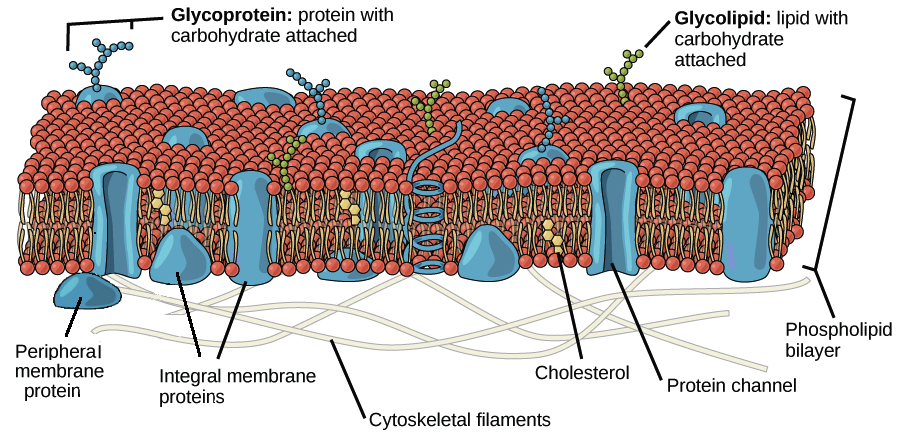Which Best Describes the Structure of a Cell's Plasma Membrane
Biologists have described a cells plasma membrane as being a fluid mosaic. What term describes the structure of a cell plasma membrane beacsue of its oily nature and embedded proteins.

Fluid Mosaic Model Of Cell Membrane S Structure Idil Ugurlu Thinglink Cell Membrane Coloring Worksheet Cell Membrane Structure Plasma Membrane
Which of the following statements is true about.

. The plasma membrane is a bilayer of lipid molecules with protein molecules embedded in it. The plasma membrane is made up primarily of a bilayer of phospholipids with embedded proteins carbohydrates glycolipids and glycoproteins and in animal cells cholesterol. In the two layers of amphipathic lipids the hydrophilic polar heads affinity for water orient themselves in and out.
The main function of the plasma membrane is to protect the cell from its surrounding environment. The interior of the lipid bilayer is hydrophobic. It is semi-permeable and regulates the materials that enter and exit the cell.
The membrane proteins help in transportation of water ions and solute across the membrane and thus provide semi permeability to the membrane. When asked to describe the structure of the Plasma Membrane the structure is usually provided by the fluid mosaic model. Which of the following best describes the structure of the membrane.
Which of the following best describes the general structure of a cell membrane. The fluid mosaic model describes the plasma membrane as a structure that is liquid and very rigid. An organelle that generates energy for the cell needs.
The plasma membrane is a composed of ear body of carbohydrates and nucleic Mitochondrion is. Briefly explain why this is an accurate description. Membrane organelle that produce proteins.
Plasma membrane is the outer covering of all the cells but only in a plant cell it is present below the cell wall. Which of the following best describes the basic structure of the plasma membrane of a cell. It is also simply called the cell membrane.
The fluid mosaic model describes the plasma membrane structure as a mosaic of componentsincluding phospholipids cholesterol proteins and carbohydratesthat gives the. Lipid bilayer glycocalyx phospholipids glycoproteins selective permeability Lipid Bilayer. Proteins embedded in two layers of phospholipid.
Describe the structure of the plasma membranecell membrane-Basic structure according to fluid mosaic model. The cell membrane is made up of two layers of amphipathic lipids and also has 20 of integral and peripheral proteins. The fundamental structure of the membrane is the phospholipid bilayer which forms a stable barrier between two aqueous compartments.
The Fluid Mosaic Model of the Plasma Membrane. Which of the following best describes a feature of the cell membranes structure that allows molecules such as oxygen and hydrocarbons to easily cross the membrane and enter the cell. The explanation the fluid mosaic model has evolved somewhat over time but it still best accounts for plasma membrane structure and function as we now understand them.
Like all other cellular membranes the plasma membrane consists of both lipids and proteins. Question 14 of 17 Select the phrases that describe the plasma membrane. Use the figure on page 74 to help with this.
The plasma membrane is a double layer of protein enclosing the plasma. As shown below proteins perform a number of functions within membranes. A cell membrane is also called the plasma membrane a thin membrane that surrounds every living cell.
Robert Hooke discovered the cell membrane in the late 1600s. Cell membranes are composed primarily of fatty-acid-based lipids and proteins. Stability of an animal cell plasma membrane is enhanced by _____.
The plasma membrane is a double layer of protein enclosing the plasma. True or False. The bilayer contains mostly polar molecules.
In the case of the plasma membrane these compartments are the inside and the outside of the cell. The fluid mosaic model of the plasma membrane structure describes the plasma membrane as a fluid combination of phospholipids cholesterol proteins and carbohydrates. The plasma membrane of a cell is a network of lipids and proteins that forms the boundary between a cells contents and the outside of the cell.
It is composed of phospholipid bilayer structure with embedded proteins. This is because the structure of the Plasma Membrane is best represented through the fluid mosaic model as a collection of cholesterol carbohydrates proteins and phospholipids. Depicts the plasma membrane as exceedingly thin 7-10nm flexible structure composed of a double layer or bilayer of lipid molecules with protein molecules plugged into it.
Creates a barrier between the inside and outside of the cell provides a rigid structure that allows the cell to hold its shape separates the nucleus and the cytosol regulates transport of molecules into and out of the cell. The term that is used is lipid bilayer. The plasma membrane is a single-layered membrane that surrounds that surrounds the nucleus of the cell.
A double layer of phospholipids with proteins is the best statement that describes the structure of the cell membrane. The proteins float in the lipid bilayer forming a changing mosaic pattern. The plasma membrane is a phospholipid bilayer surrounding the cell.
The plasma membrane is a phospholipid bilayer surrounding the cell. The bilayer is embedded with transport proteins. The structure and properties of the cell membrane allow it to be selective and maintain homeostasis.

Honors Biology Lawrenceville Cells Plasma Membrane Cell Membrane Cell Membrane Coloring Worksheet

Structure Of The Plasma Membrane Article Khan Academy

Cell Membranes Function Structure And Composition Cell Membrane Cell Membrane Plasma Membrane Cell Biology
Comments
Post a Comment